
The royal coat of arms of the United Kingdom, or the royal arms for short, is the arms of dominion of the British monarch, currently Queen Elizabeth II. These arms are used by the Queen in her official capacity as monarch of the United Kingdom. Variants of the royal arms are used by other members of the British royal family, by the British Government in connection with the administration and government of the country, and some courts and legislatures in a number of Commonwealth realms. A Scottish version of the royal arms is used in and for Scotland. The arms in banner form serve as basis for the monarch's official flag, the Royal Standard.
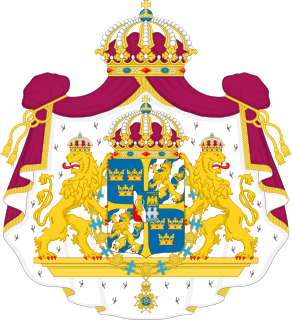
The coat of arms of the Kingdom of Sweden has a greater and a lesser version.

The national flag of Spain, as it is defined in the Constitution of 1978, consists of three horizontal stripes: red, yellow and red, the yellow stripe being twice the size of each red stripe. Traditionally, the middle stripe was defined by the more archaic term of gualda, and hence the popular name la Rojigualda (red-weld).

In heraldry, an escutcheon is a shield that forms the main or focal element in an achievement of arms. The word can be used in two related senses. In the first sense, an escutcheon is the shield upon which a coat of arms is displayed. In the second sense, an escutcheon can itself be a charge within a coat of arms.

The coat of arms of Spain represents Spain and the Spanish nation, including its national sovereignty and the country's form of government, a constitutional monarchy. It appears on the flag of Spain and it is used by the Government of Spain, the Cortes Generales, the Constitutional Court, the Supreme Court, and other state institutions. Its design consists of the arms of the medieval kingdoms that would unite to form Spain in the 15th century, the Royal Crown, the arms of the House of Bourbon, the Pillars of Hercules and the Spanish national motto: Plus Ultra. The Monarch, the heir to the throne and some institutions like the Senate, the Council of State and the General Council of the Judiciary have their own variants of the coat of arms.

The coat of arms of Norway is the arms of dominion of king Harald V of Norway, and as such represents both the monarch and the kingdom. It depicts a standing golden lion on a red background, bearing a golden crown and axe with silver blade.

The Revolt of the Comuneros was an uprising by citizens of Castile against the rule of Charles I and his administration between 1520 and 1521. At its height, the rebels controlled the heart of Castile, ruling the cities of Valladolid, Tordesillas, and Toledo.
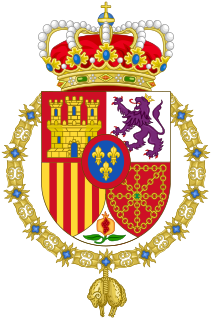
The coat of arms of the King of Spain is the heraldic symbol representing the monarch of Spain. The current version of the monarch's coat of arms was adopted in 2014 but is of much older origin. The arms marshal the arms of the former monarchs of Castile, León, Aragon, and Navarre.

The coat of arms of Gibraltar was first granted by a Royal Warrant passed in Toledo on 10 July 1502 by Isabella I of Castile during Gibraltar's Spanish period. The arms consists of an escutcheon and features a three-towered red castle under which hangs a golden key.
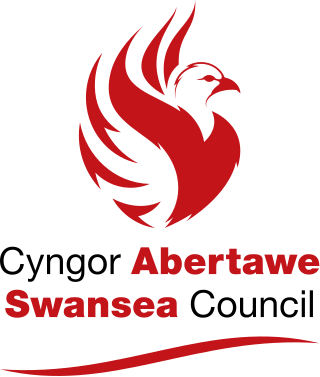
The City and County of Swansea Council is the governing body for one of the Principal Areas of Wales covering Swansea, Gower and the surrounding area. The council consists of 75 councillors representing 32 electoral wards.
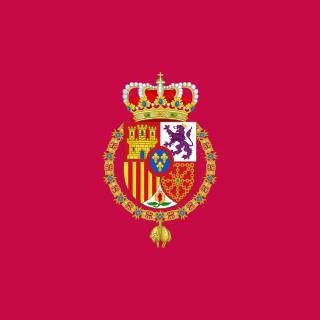
The Royal Standard of Spain is the official flag of the King of Spain. It comprises a crimson square, traditional colour of both Castilian and Spanish monarchs, with the coat of arms of the King in the center. It is raised over the official royal residence in Madrid, the Palacio de la Zarzuela and other Spanish royal sites, when the monarch is in residence and displayed on his official car as small flag. The current flag was adopted when Felipe VI acceded the throne as King of Spain on 19 June 2014. The Royal Standard is regulated by Rule 2 of Royal Decree 527/2014, 20 June, an amendment to Title II of Spanish Royal Decree 1511/1977 adopting Flags, Standards, Guidons, Insignia and Emblems Regulation.
Spain has many coats of arms: the nation has one, the reigning monarch and the heir presumptive each have one, and there are others for the institutions of state and for Spanish regions and towns.

The Order of Isabella the Catholic is a Spanish civil order and honor granted to persons and institutions in recognition of extraordinary services to the homeland or the promotion of international relations and cooperation with other nations. The Order is open not only to Spaniards; it has been granted to many foreigners.

Panamá Viejo, also known as Panamá la Vieja, is the remaining part of the original Panama City, the former capital of Panama, which was destroyed in 1671 by the Welsh privateer Henry Morgan. It is located in the suburbs of the current capital. Together with the historical district of Panamá, it has been a World Heritage Site since 1997.
A heraldic authority is defined as an office or institution which has been established by a reigning monarch or a government to deal with heraldry in the country concerned. It does not include private societies or enterprises which design and/or register coats of arms. Over the centuries, many countries have established heraldic authorities, and several still flourish today.

Castrojeriz or Castrogeriz is a locality and municipality located in the province of Burgos, in the autonomous community of Castilla y León (Spain), the comarca of Odra-Pisuerga, the judicial district of Burgos, head of the town council of the same name and former head of the Castrojeriz judicial district.

The Seal of Manila is composed of the city's modern coat-of-arms, with colors mirroring those of the Philippine National Flag. It is a modified form of the city's historical arms bestowed in the 16th century.

The coat of arms of the Region of Murcia is described in the article 4 of the Spanish Organic Law 4 of 9 June 1982, the Statute of Autonomy of the Region of Murcia and further regulated by Decree 34 of 8 June 1983, approving the official design and use of the coat of arms of the Region of Murcia.

The coat of arms of Castile was the heraldic emblem of its monarchs. Historian Michel Pastoureau says that the original purpose of heraldic emblems and seals was to facilitate the exercise of power and the identification of the ruler, due to what they offered for achieving these aims. These symbols were associated with the kingdom, and eventually also represented the intangible nature of the national sentiment or sense of belonging to a territory.
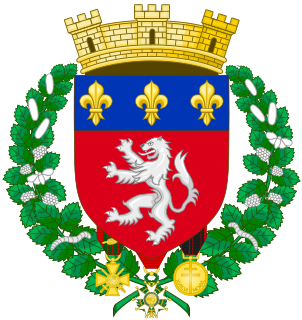
The coat of arms of Lyon, the ancient capital of the Gauls, reflects the rich history of the city across different periods of its existence and the power that has exercised authority over the city. It was created in 1320, although the current version, which dates from 1859, reprises the form that it had before the end of the Ancien Régime after having undergone several temporary modifications.




















